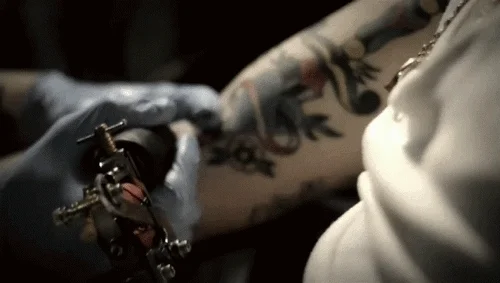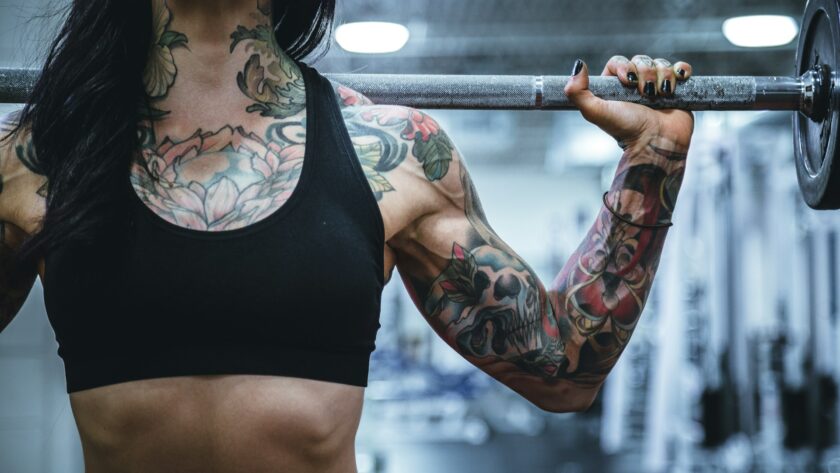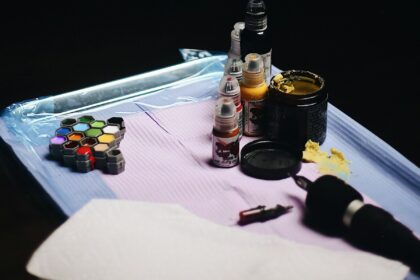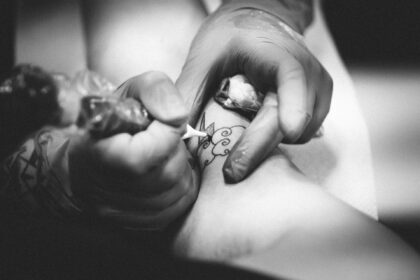Tattoos have become a popular way for people to express their identities and commemorate significant life events. As more individuals combine their love for tattoos with a commitment to fitness, understanding how muscle gain affects tattoos is increasingly important. Muscle growth can cause the skin to stretch, which may lead to changes in the appearance of tattoos.
These changes include distortion, fading, and in some cases, wrinkling. Knowing how your body art might change as your muscles grow helps you make better decisions about tattoo placement, design, and timing. Whether you’re a bodybuilder or someone new to fitness, being aware of the potential impact of muscle gain on your tattoos allows you to plan effectively and maintain the quality and meaning of your ink over time.
Understanding Tattoo Composition and Skin Anatomy
Tattoos involve injecting ink into the dermis layer of the skin, where it becomes permanent. The dermis, located beneath the epidermis, holds the ink in place, ensuring that the design remains visible as the outer layer of skin regenerates. The skin’s elasticity, largely determined by collagen and elastin fibers, plays a crucial role in how tattoos age.

Image source https://giphy.com/gifs/art-hand-tattoo-IPDpv0W2sQrKg
When you gain muscle, the skin needs to stretch to accommodate the increased muscle mass. This stretching process can affect how the tattoo looks, especially if the skin’s elasticity is compromised or if the design is intricate. Understanding the relationship between skin structure and tattoo placement can help minimize undesirable changes to your ink as your muscles grow. Choosing the right tattoo location and design can help maintain the integrity and appearance of your body art even as your physique changes.
Impact of Muscle Gain on Tattoos
Muscle gain directly impacts the skin by stretching it to accommodate growing muscle fibers. As your muscles increase in size, the skin covering them must also expand, which can lead to changes in the appearance of your tattoos. The degree to which a tattoo changes depends on several factors, including the amount of muscle gained, the elasticity of your skin, and the location and design of the tattoo.
For example, larger muscle groups like the biceps, chest, and back are more prone to noticeable changes. Tattoos on these areas may stretch, causing the design to appear distorted or warped. Intricate designs, in particular, may suffer more from these changes because small details can become blurred or misaligned as the skin stretches. Understanding these potential changes can help you better plan your tattoos, especially if you anticipate significant muscle growth in the future.
Specific Changes in Tattoo Appearance
As muscles grow and stretch the skin, tattoos may undergo several visible changes. The most common change is distortion, where the tattoo design becomes stretched or warped. This is especially noticeable in tattoos with intricate patterns or fine details. When muscles expand, the skin stretches unevenly, which can cause straight lines to bend and circular designs to lose their shape.
Additionally, color fading is another issue that can occur as the skin stretches. The stretching process can cause the ink to disperse slightly, leading to a less vibrant appearance. Tattoos might also develop wrinkles or an uneven texture, particularly in areas where stretch marks form. Stretch marks can disrupt the smoothness of the skin, causing the tattoo to appear uneven or jagged. These changes underscore the importance of considering both the design and placement of tattoos if you plan to gain significant muscle mass.
Mitigating and Managing Tattoo Distortion
To minimize tattoo distortion from muscle gain, careful planning is essential. One effective strategy is to choose tattoo placements on areas of the body that are less likely to experience significant muscle growth. For instance, forearms, calves, and shoulders typically undergo less change compared to larger muscle groups like the chest or thighs. Additionally, selecting tattoo designs that are simple and bold can help reduce noticeable distortion.
Designs with thick lines and less intricate details are more likely to retain their original appearance even as the skin stretches. Timing your tattoos is also crucial; if you plan to undergo a significant body transformation, it might be wise to delay getting new tattoos until after you’ve achieved your desired muscle size. This way, you can ensure that the design will fit your final physique and minimize the risk of distortion as you continue to grow.
Tattoo Maintenance Post Muscle Gain
Maintaining the appearance of your tattoos after muscle gain requires ongoing care and attention. Keeping your skin hydrated is one of the most effective ways to preserve tattoo quality. Regular moisturizing helps maintain skin elasticity, allowing it to stretch without damaging the tattoo. Using skincare products designed to support skin health, such as those containing collagen or hyaluronic acid, can also enhance the skin’s ability to adapt to changes in muscle size.

If your tattoo has already experienced some distortion, a touch-up session with a skilled tattoo artist can help restore its original look. Artists can add details, adjust colors, or even slightly modify the design to better suit your new muscle contours. By taking these steps, you can ensure that your tattoos continue to look vibrant and well-defined, even as your body changes through muscle gain.
Conclusion
When you combine a love for tattoos with a passion for building muscle, understanding how your ink may change becomes crucial. Muscle gain can cause noticeable alterations in tattoos, from stretching and distortion to fading and wrinkling. However, with thoughtful planning, these changes can be minimized.
Selecting the right placement and design, considering the timing of your tattoo, and maintaining a good skincare routine are all key strategies in preserving your tattoo’s appearance as your body changes. Additionally, understanding the anatomy of the skin and how it interacts with muscle growth can help you make more informed decisions, ensuring that your tattoos remain a source of pride no matter how your physique evolves. By staying informed and proactive, you can enjoy both your tattoos and your fitness journey without sacrificing one for the other.
FAQ: What Happens To Tattoos When You Gain Muscle?
1. Will my tattoo stretch if I gain muscle?
Yes, as you gain muscle, your skin will stretch to accommodate the increased muscle mass. This stretching can cause your tattoo to expand, potentially distorting the design. The extent of the stretching depends on how much muscle you gain and where the tattoo is located on your body.
2. Which tattoos are most likely to get distorted?
Tattoos on areas with large muscle groups, such as the biceps, chest, shoulders, and back, are most prone to distortion. Intricate designs with fine details are also more susceptible to changes, as even slight stretching can cause lines to blur or shapes to warp.
3. How can I prevent my tattoo from distorting as I build muscle?
To minimize distortion, consider placing tattoos on areas of your body that are less likely to undergo significant muscle growth, such as the forearms, calves, or lower back. Opt for simpler, bolder designs, as they tend to hold up better to stretching. Additionally, timing your tattoo after reaching your desired muscle size can help ensure the design remains intact.
4. Can muscle gain cause my tattoo to fade?
Muscle gain can lead to some degree of fading, particularly if the skin stretches significantly. As the skin stretches, the ink may disperse slightly, making the colors appear less vibrant. Maintaining proper skin care, such as moisturizing regularly, can help preserve the vibrancy of your tattoo.
5. Will stretch marks affect my tattoo?
Yes, stretch marks can impact your tattoo by creating lines or grooves that disrupt the smooth surface of the skin. This can cause the tattoo to appear uneven or distorted in the areas where stretch marks develop. Using skincare products that improve skin elasticity may help reduce the likelihood of stretch marks forming.
6. Should I wait to get a tattoo until after I’ve gained muscle?
If you’re planning a significant body transformation, it might be wise to wait until you’ve achieved your desired muscle size before getting a tattoo. This approach helps ensure that your tattoo will fit your final physique, minimizing the risk of distortion as your muscles grow.
7. Can I get a tattoo touch-up after gaining muscle?
Yes, if your tattoo has changed in appearance due to muscle gain, a skilled tattoo artist can perform a touch-up to restore its original look. They may adjust details, enhance colors, or slightly modify the design to better suit your new muscle contours.
8. Is there a way to completely avoid tattoo changes with muscle gain?
While it’s difficult to completely avoid changes in your tattoo with muscle gain, you can minimize these effects by choosing appropriate tattoo placement, design, and timing. Keeping your skin healthy and elastic through proper skincare also plays a crucial role in maintaining the appearance of your tattoo.
9. How does skin elasticity affect my tattoo when I gain muscle?
Skin elasticity, determined by the collagen and elastin fibers in your skin, helps your skin stretch and return to its original shape. High elasticity allows your skin to accommodate muscle growth without causing significant changes to your tattoo. On the other hand, lower elasticity can lead to more noticeable stretching and distortion.
10. Can I still get a tattoo if I’m planning to bulk up significantly?
Yes, you can still get a tattoo if you’re planning to bulk up, but it’s important to plan carefully. Discuss your goals with your tattoo artist, choose placements that are less prone to distortion, and consider the design’s complexity. Waiting until after you’ve achieved your muscle growth goals may also be a good strategy.





